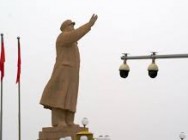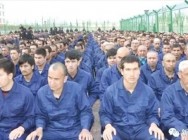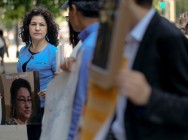Last Minute

- Conflict and Alliance: The US and China: A Centennial Dance: A Century of Relationship from 1900 to 2024
- CHINA RELATIONSEAST TURKESTAN PROBLEM AND TURKEY
- FRONTLINE China Undercover
- Elimination of “Uyghur Counter-Revolutionary Officials” in Academic Fields—Exact Quotes Translated from a Mandarin Audio File
- In Push for Trade Deal, Trump Administration Shelves Sanctions Over China’s Crackdown on Uighurs
- Dalai Lama’s 60th Anniversary Symposium: İlshat Hassan speech in English and Chinese
- Uyghur Detainees from Xinjiang ‘Placed in Nearly Every Prison’ in Shandong Province
- Shahrezad Ghayrat, Unrepresented Women
- Uighur Americans Speak Against China’s Internment Camps. Their Relatives Disappear.
- Rozinisa: The true story of the Uyghur girls in the prison

-

Conflict and Alliance: The US and China: A Centennial Dance: A Century of Relationship from 1900 to 2024
-

CHINA RELATIONSEAST TURKESTAN PROBLEM AND TURKEY
-

FRONTLINE China Undercover
-

Elimination of “Uyghur Counter-Revolutionary Officials” in Academic Fields—Exact Quotes Translated from a Mandarin Audio File
-

In Push for Trade Deal, Trump Administration Shelves Sanctions Over China’s Crackdown on Uighurs
-

Dalai Lama’s 60th Anniversary Symposium: İlshat Hassan speech in English and Chinese
China Executed More Than 2,000 People Last Year: Rights Group
Chinese authorities executed some 2,400 people in 2013, with a similar number of death penalties expected to be carried out this year, according to estimates from a U.S.-based rights group.
The figures represent a sharp fall across much of China, but the Dui Hua Foundation said the number of executions carried out in the troubled northwestern region of Xinjiang, which has been hit by a wave of violence in recent years, will likely offset falling death penalty rates in the rest of the country.
“China executed approximately 2,400 people in 2013 and will execute roughly the same number of people in 2014,” the group said in a statement on its website.
“Annual declines in executions recorded in recent years are likely to be offset in 2014 by the use of capital punishment in anti-terrorism campaigns in Xinjiang and the anti-corruption campaign nationwide,” it said, citing Chinese media reports and information supplied by a high-ranking judicial official of the ruling Chinese Communist Party.
While China still executes more people annually than the rest of the world put together, the figure is just one-tenth of the number put to death during the “strike hard” anti-crime campaigns of the 1980s, the Foundation said in the report this week.
In 2007, the country ordered that all death penalty cases must be reviewed by the Supreme People’s Court in Beijing, and the number of executions appears to have fallen sharply in many regions since then, the group said in a statement on its website.
“The number of executions nationwide may have dropped by more than a third with declines of nearly 50 percent in some locales,” the statement cited the Guangzhou-based Southern Weekly newspaper as saying.
Abuse of power
Beijing-based lawyer Hao Jinsong said the compulsory review by the Supreme People’s Court was the major factor in the fall in execution numbers.
“The power to review death penalty cases used to lie with the provincial high courts, but they weren’t rigorous enough,” Hao said.
“A lot of cases were waved through with no evidence, or insufficient evidence, resulting in a lot of miscarriages of justice,” he said.
Hao said the 2007 ruling had come after a long-term campaign by China’s increasingly vocal legal profession.
But he said he thought 2,400 executions is still too many. “I hope that they will be able to reduce the use of the death penalty still further,” Hao said.
“The elimination of the death penalty in non-violent or economic crimes is a step on the way to total elimination of the death penalty,” he said.
Professor Xia Ming, of New York’s City University, said China’s use of the death penalty amounted to an abuse of the government’s power.
“For China to be executing so many people shows that the Chinese government is abusing the use of the death penalty,” Xia said.
“In the 60 or more years of the regime, China has executed … more than a million people, which means there are around 10 million family members of people put to death,” he said.
“Eventually, the government will be forced into a position where it is treating its own people as the enemy.”
Dramatic reduction
The Dui Hua report said the review of death penalties by the Supreme People’s Court appears to have had a dramatic effect on execution figures.
At the height of the “strike hard” campaigns in 1983, during which provincial courts were allowed to hand down the death penalty, some 24,000 people were executed, Southern Weekend quoted official historical records as saying.
The number of executions carried out annually is regarded as a state secret in China, but a high-ranking official told Dui Hua executive director John Kamm in early 2014 that the number of executions fell by around 20 percent in 2013, compared with the whole of the previous year, the group said.
In 2013, 39 percent of all death penalty cases reviewed by the court were sent back to provincial high courts for additional evidence, among them the case of domestic violence survivor Li Yan, against whom homicide charges were eventually dropped in spite of an initial death penalty.
Four-fifths of the cases reviewed by the Supreme People’s Court between July 2013 and September 2014 involved murders, and the court only overturned five of them, while only 13 review cases involved hearing arguments from defense attorneys, Dui Hua cited the court’s official website as saying.
It said the largest number of review cases came from Yunnan, Xinjiang, Zhejiang, Guangdong and Henan, with an average review time of six months.
Xinjiang cases
Last August, Chinese authorities in Xinjiang executed eight suspected ‘terrorists’ for involvement in an Oct. 28, 2013 jeep attack on Tiananmen Square, as well as other violent clashes with the authorities in Xinjiang’s Aksu, Kashgar and Hotan prefectures.
But lawyers said at the time the death penalty is unlikely to put an end to violence in the region, where many of the mostly Muslim ethnic Uyghur minority say they suffer discrimination and religious oppression under Chinese rule.
The exile World Uyghur Congress condemned the executions, saying such cases are often brought very quickly, with no opportunity for a full investigation or appeals process.
Hundreds have died in violence in Xinjiang over the past year, prompting a year-long “anti-terrorism” crackdown which Chinese authorities have blamed on “separatists” whose attacks have increased in scale and sophistication with overseas help.
Reported by Gao Shan for RFA’s Mandarin Service, and by Pan Jiaqing for the Cantonese Service. Translated and written in English by Luisetta Mudie.
http://www.rfa.org/english/news/china/executions-10222014170918.html
RELATED NEWS












